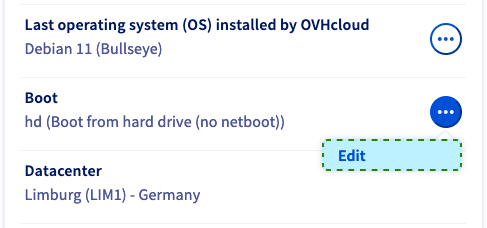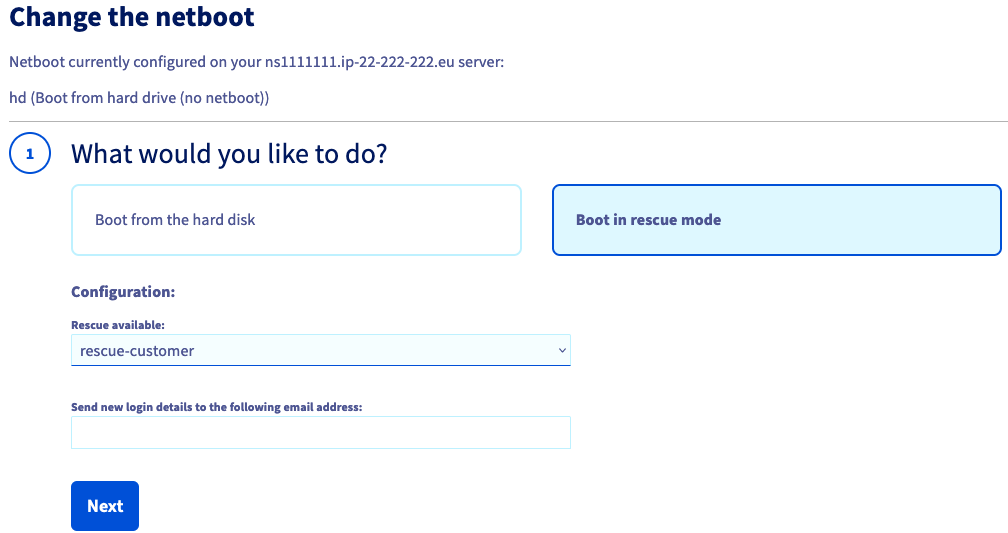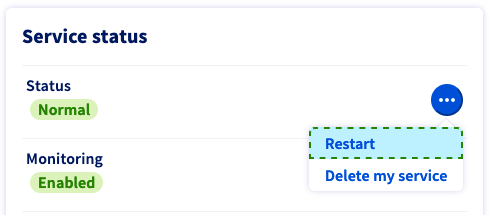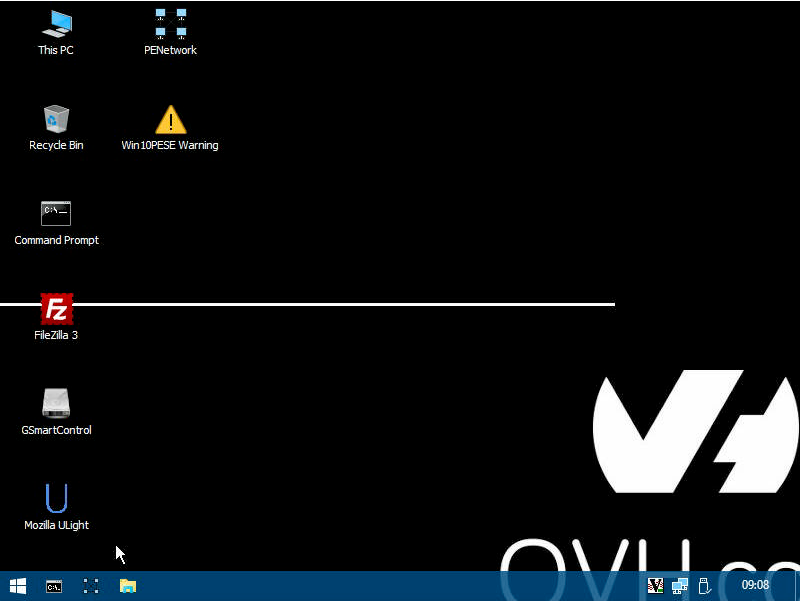Unable to Reload a Running Vps Please Stop the Vps and Try Again
Last updated 2nd May 2022
Objective
Rescue mode is a tool on your server that allows yous to kick into a temporary operating organization for the purpose of diagnosing and resolving bug.
Usual tasks the rescue mode is appropriate for include:
- Resetting your root password
- Diagnosing network issues
- Repairing a broken operating system
- Fixing a software firewall misconfiguration
- Testing disk performance
- Testing CPU and RAM
Backing up your information should exist the first footstep in rescue mode if you exercise not already have contempo backups bachelor.
This guide will evidence you lot how to actuate and use your server'southward rescue mode.
Requirements
- A dedicated server in your OVHcloud account
- Admission to the OVHcloud Control Panel
Instructions
Please note that if yous have prepare a default SSH cardinal in your command console for dedicated products, you volition non receive a root countersign when rebooting a server rescue mode. In this case, you must offset disable the cardinal earlier proceeding. To practice so, please consult this section of the relevant guide.
Y'all can activate rescue way only from your OVHcloud Command Console. Go to the Bare Metal Cloud section and so select the server on which to enable rescue mode from Dedicated Servers.
Look for "Boot" in the Full general information box and click on ..., then on Edit.

In the next folio, select Boot in rescue manner. If your server has a Linux-based Os, select rescue-customer from the menu. If your server runs on Windows, you can also choose "WinRescue" (run across the guide department beneath). Specify an alternative email accost below if you practise non want the login credentials sent to your customer business relationship'southward main address.
Click on Adjacent to proceed to the side by side step and on Ostend to validate the change.

Once the change is completed, click on ... next to "Status" in the box labelled Service status. Select Restart and the server will restart into rescue style.
This might take a few minutes; yous can bank check the status on the Tasks tab. An email will be sent which contains some data and the login password for the rescue way's "root" user.

Think to change the netboot back to Boot from the hd before restarting after finishing your rescue mode tasks.
Linux
Using rescue fashion (SSH)
If you are using an SSH key (too active in the OVHcloud Control Panel), you volition not be sent a password. Once the server is in rescue mode, you lot tin can connect directly via your SSH key.
Once your server has rebooted, you will receive an email with your rescue manner admission credentials. This email is also available in your OVHcloud Control Panel as soon as it is sent: Click on the name associated with your NIC handle (Customer ID) in the menu bar in the top right-mitt corner, so select Service emails.
You lot will and so demand to admission your server via the command line or an SSH tool, using the root countersign generated for the rescue manner.
For example:
ssh root@your_server_IP root@your_server_password: Your SSH client will likely block the connection at first due to a mismatch of the ECDSA fingerprint. This is normal because the rescue way uses its ain temporary SSH server.
1 manner around this is commenting the fingerprint of your regular organisation by adding a # in front end of its line in the known_hosts file. Revert that alter before returning to normal boot.
For well-nigh changes y'all make to your server via SSH while in rescue way, you will need to mount a partition. This mode has its own temporary file organization, so whatsoever file system changes y'all make in rescue mode volition be lost one time y'all reboot the server in normal style.
Yous can mount partitions using the mountain command in SSH. Firstly, list your partitions in club to remember the proper name of the division you need to mount. You tin refer to the following code examples:
rescue-client:~# fdisk -l Deejay /dev/hda 40.0 GB, 40020664320 bytes 255 heads, 63 sectors/track, 4865 cylinders Units = cylinders of 16065 * 512 = 8225280 bytes Device Kick Start Stop Blocks Id Organisation /dev/hda1 * 1 1305 10482381 83 Linux /dev/hda2 1306 4800 28073587+ 83 Linux /dev/hda3 4801 4865 522112+ 82 Linux swap / Solaris Disk /dev/sda 8254 MB, 8254390272 bytes 16 heads, 32 sectors/track, 31488 cylinders Units = cylinders of 512 * 512 = 262144 bytes Device Boot Start Finish Blocks Id Organization /dev/sda1 1 31488 8060912 c W95 FAT32 (LBA) Once you have establish the name of the partitioning you want to mount, use the control beneath:
rescue-customer:~# mount /dev/hda1 /mnt/ Your sectionalisation will now be mounted. You can and then carry out operations on the file system.
If your server uses a softRAID configuration, you will need to mountain your RAID book (normally /dev/mdX).
To exit rescue way, alter the kicking way back to Boot from the hard disk drive in the OVHcloud Control Panel and restart the server from the command line.
Mounting a datastore
You can mount a VMware datastore in a similar way as described in the previous segment. Firstly, install the necessary bundle:
rescue-customer:~# apt-become update && apt-get install vmfs-tools So listing your partitions in social club to retrieve the name of the datastore division:
rescue-client:~# fdisk -l Now mount the partition with the following command, replacing sdbX with the value identified in the previous stride:
rescue-customer:~# vmfs-fuse /dev/sdbX /mnt To go out rescue style, modify the boot way back to Boot from the hard disk in the OVHcloud Control Console and restart the server from the command line.
Windows
Using WinRescue tools
Once your server has rebooted, you will receive an e-mail with your rescue manner access credentials. This email is also available in your OVHcloud Control Panel equally shortly as information technology is sent: Click on the proper noun associated with your NIC handle (Customer ID) in the carte bar in the acme right-hand corner, and so select Service emails.
To utilize the Windows rescue fashion GUI, you lot will demand to download and install a VNC panel or use the IPMI module in the OVHcloud Control Panel.

The post-obit tools are already installed in this way:
| Tool | Description |
|---|---|
| Mozilla ULight | A web browser. |
| Memory Diagnostics Tool | A Windows tool to examination the RAM. |
| Explorer_Q-Dir | An culling file explorer. |
| GSmartControl | A tool to check HDDs and SSDs. |
| PhotoRec | A tool to recover possibly lost files from a disk. |
| SilverSHielD | A SSH2 and SFTP server. |
| System Recovery | The built-in Windows organisation restore and troubleshooting tool. |
| TestDisk | A powerful data recovery awarding. You can use it to recover and modify corrupted partitions, find lost partitions, repair a boot sector and even rebuild a defective MBR. |
| FileZilla | An open-source FTP client. Information technology supports SSH and SSL protocols, and has a clear and intuitive drag-and-drop interface. You lot can utilise information technology to transfer your data to an FTP server, similar the FTP fill-in service included with most OVHcloud server models. |
| 7-Nothing | A utility for compressing and archiving files, which reads the post-obit formats: ARJ, CAB, CHM, CPIO, CramFS, DEB, DMG, Fat, HFS, ISO, LZH, LZMA, MBR, MSI, NSIS, NTFS, RAR, RPM, SquashFS, UDF, VHD, WIM, XAR and Z. You tin can also utilize it to create your own archives in the following formats: BZIP2, GZIP, TAR, WIM, XZ, Z and ZIP. |
Go farther
Irresolute the admin password on a Windows defended server
Join our community of users on https://customs.ovh.com/en/.
Did you find this guide useful?
Delight feel free to give any suggestions in society to improve this documentation.
Whether your feedback is about images, content, or structure, please share it, and then that we can ameliorate it together.
Your support requests will non be processed via this grade. To practise this, please use the "Create a ticket" form.
Thank you. Your feedback has been received.
These guides might likewise interest you lot...
Source: https://docs.ovh.com/asia/en/dedicated/ovh-rescue/
0 Response to "Unable to Reload a Running Vps Please Stop the Vps and Try Again"
Post a Comment